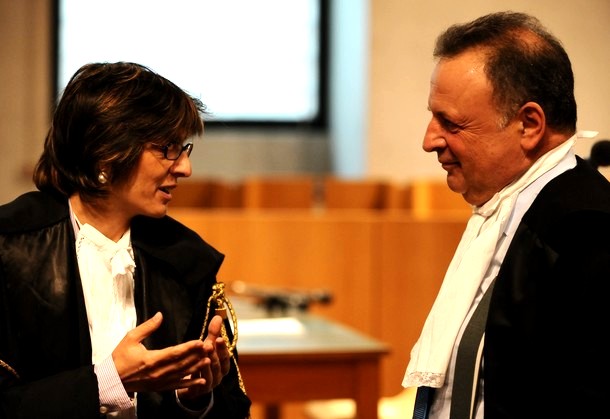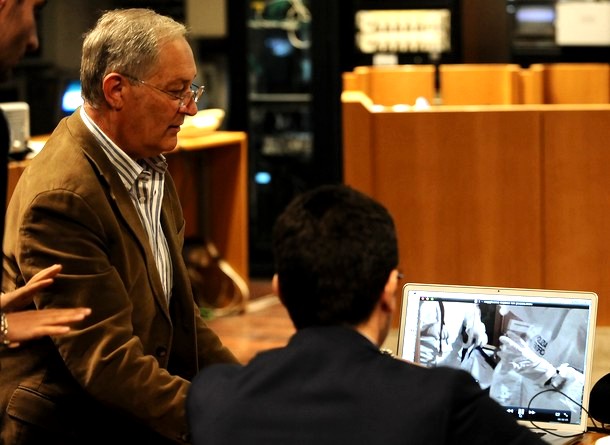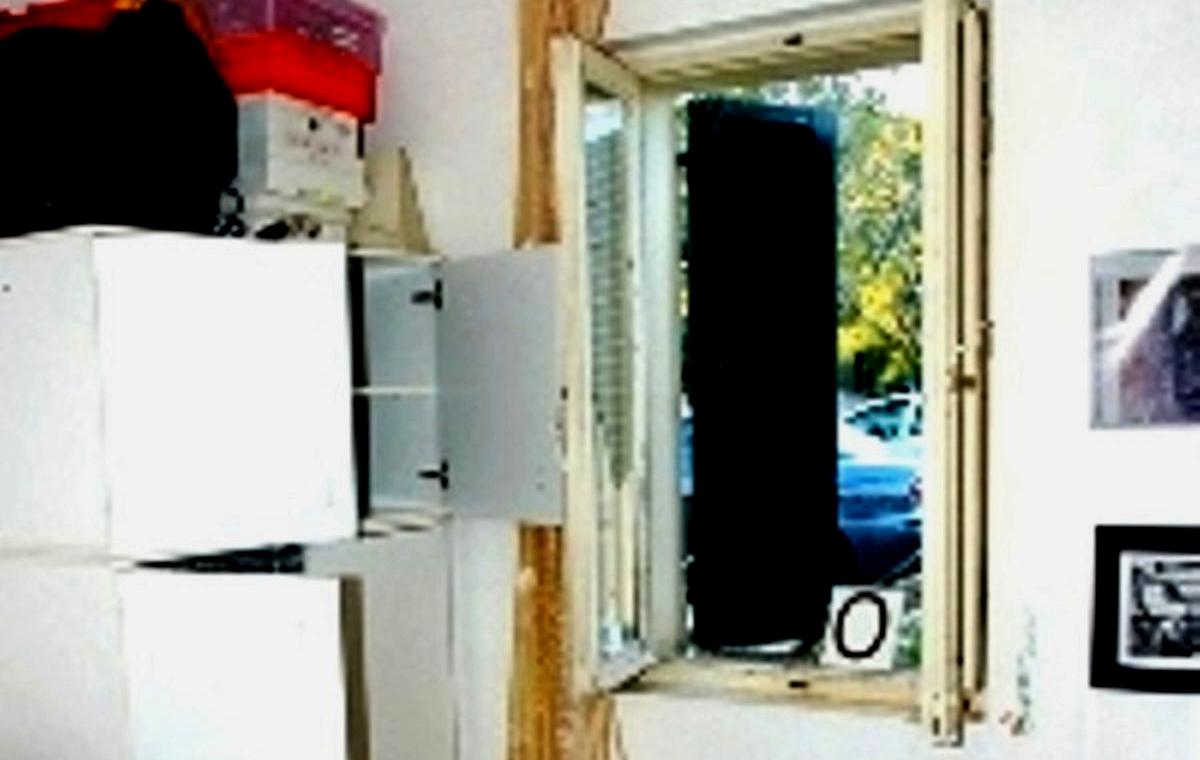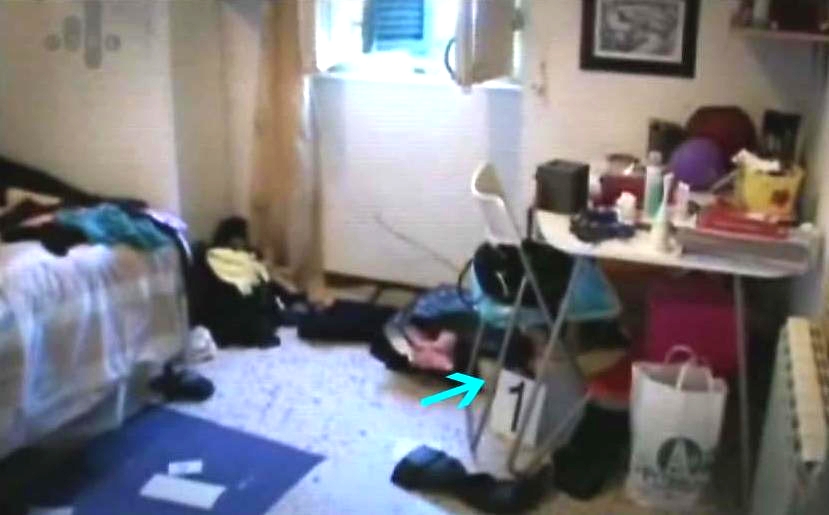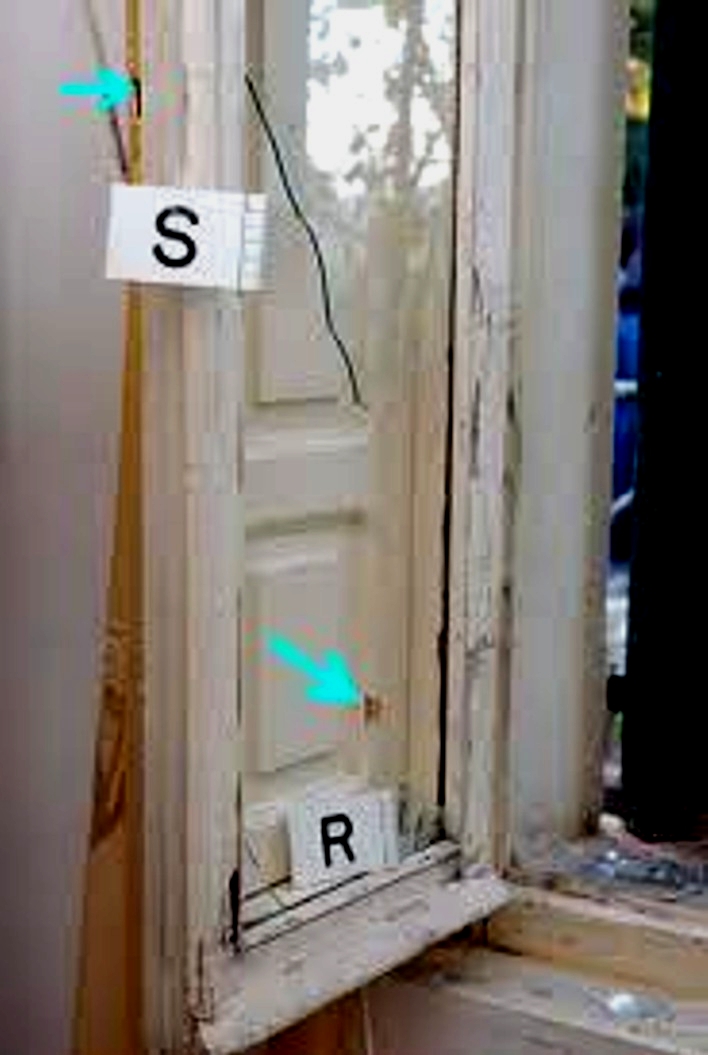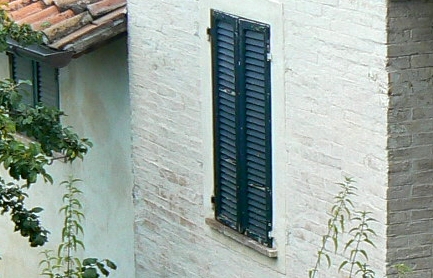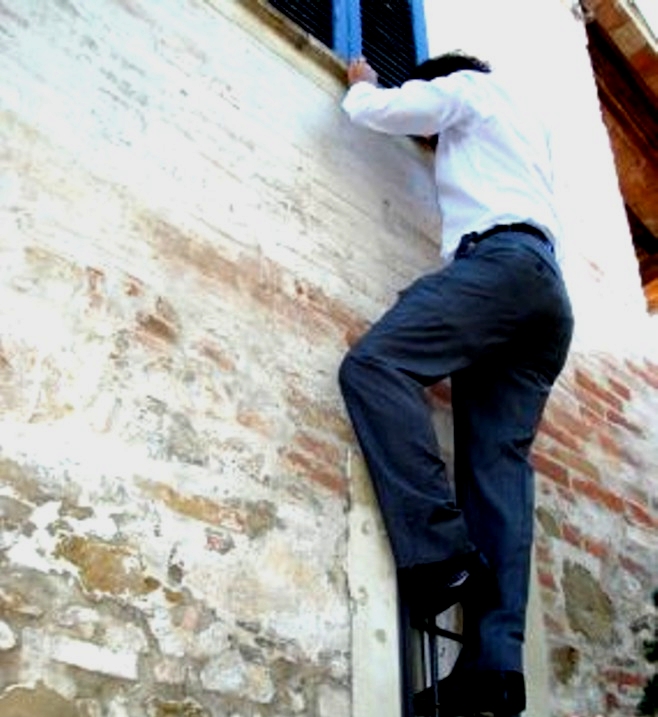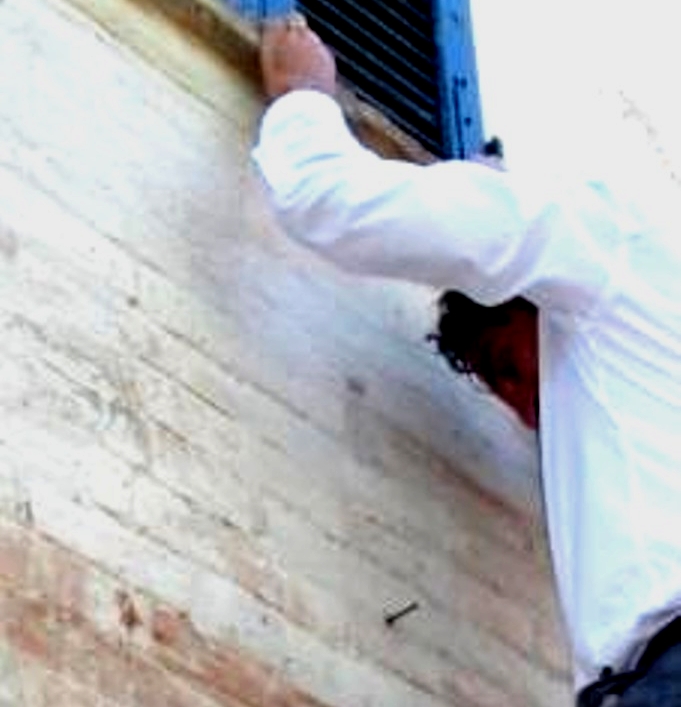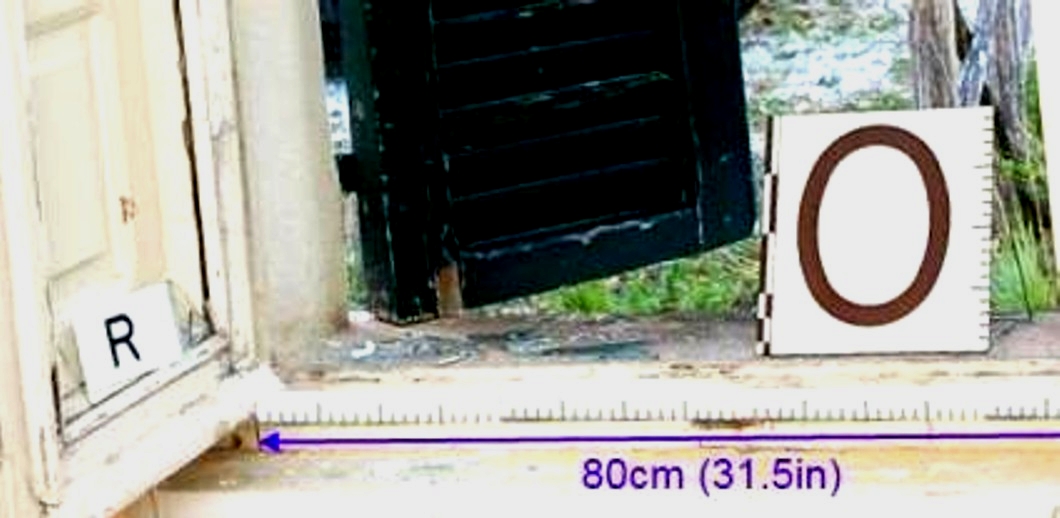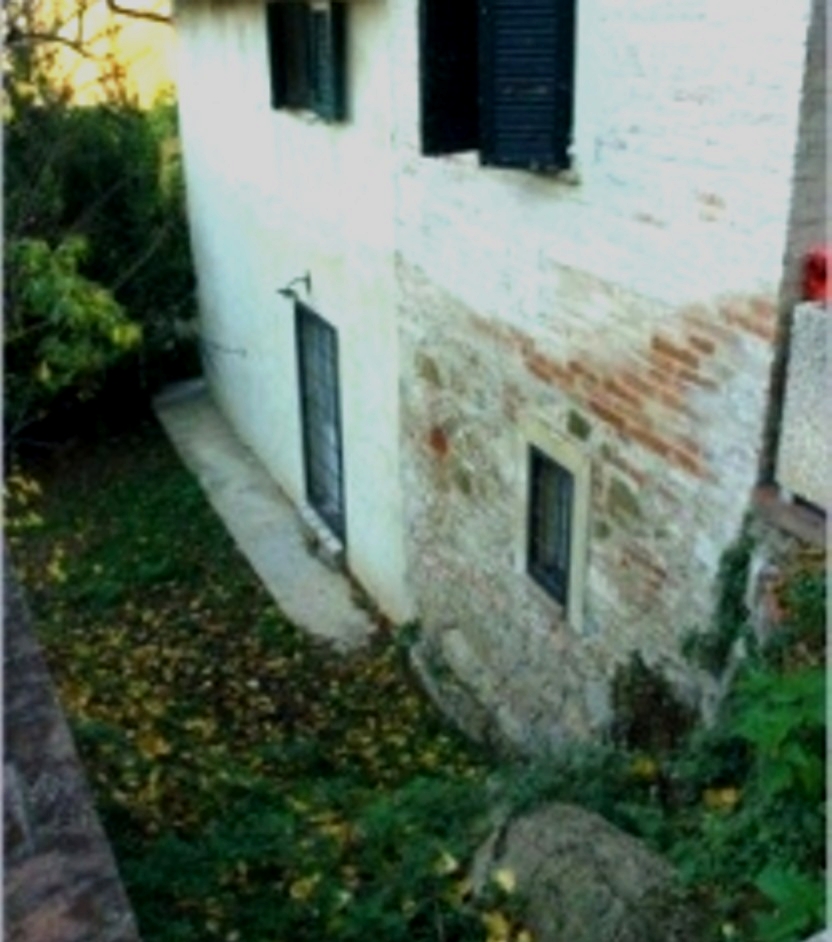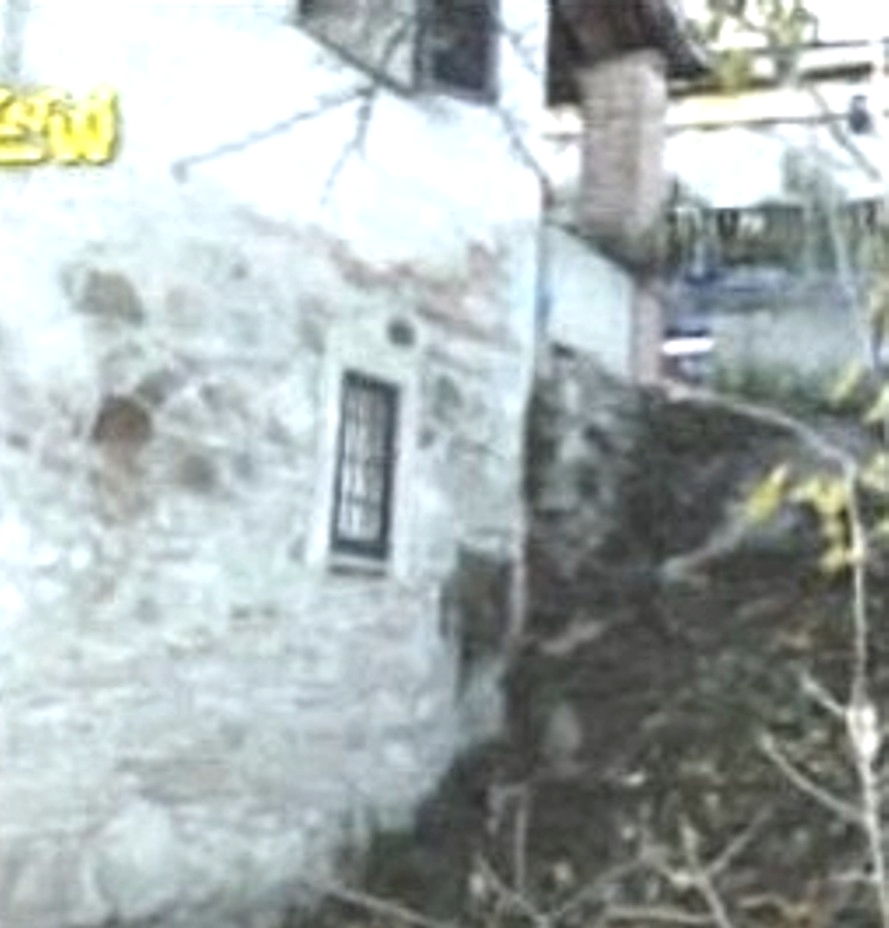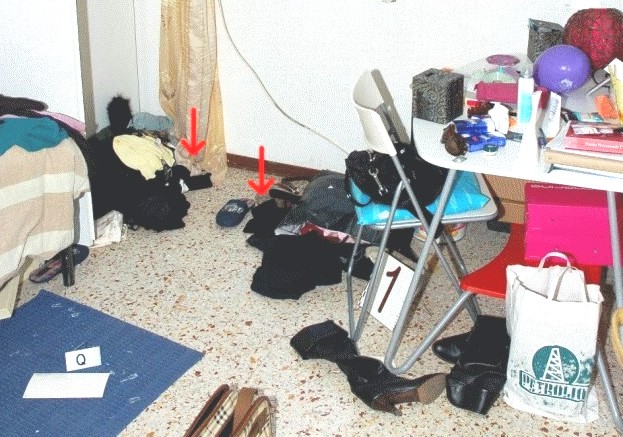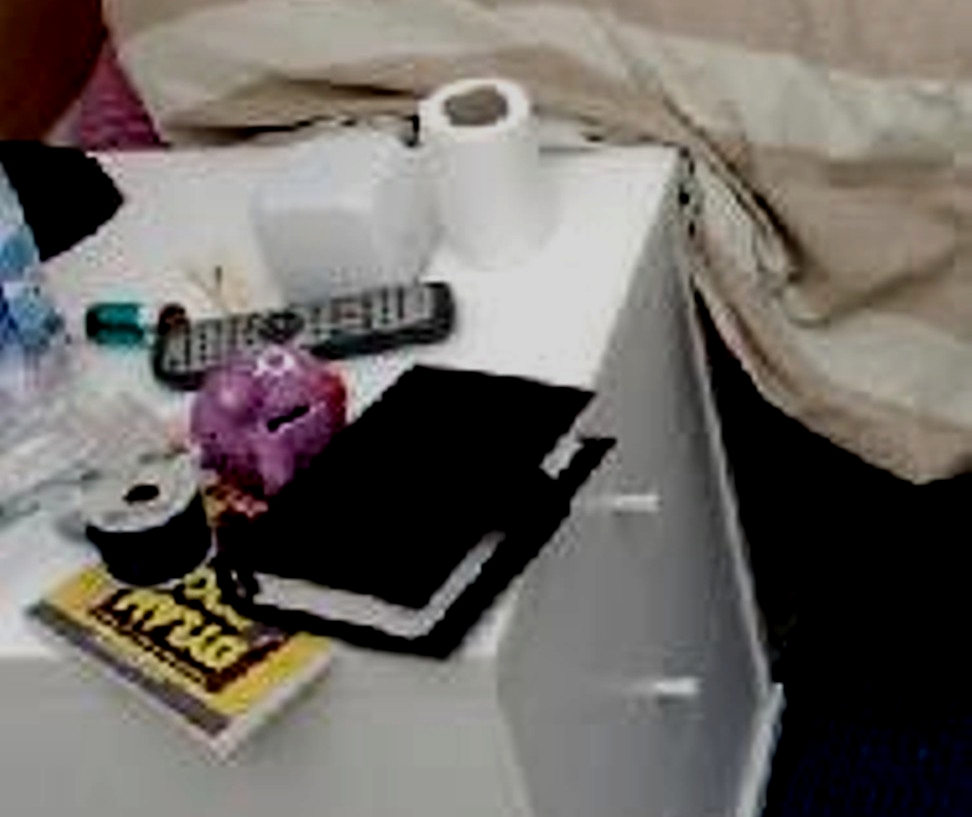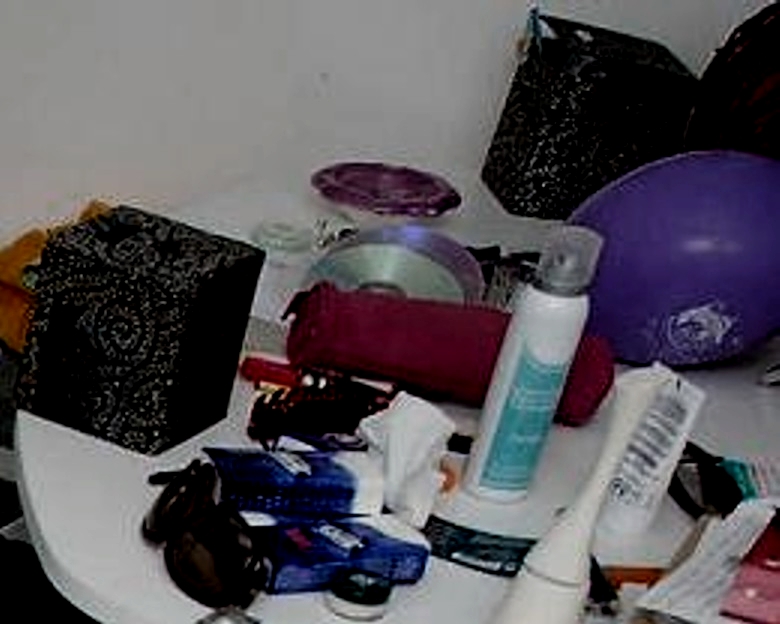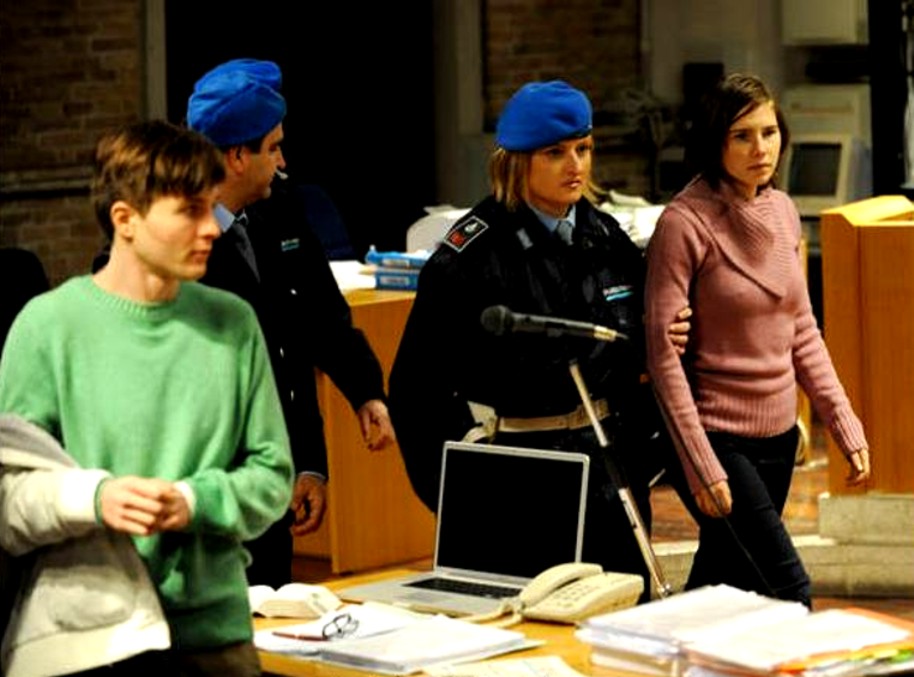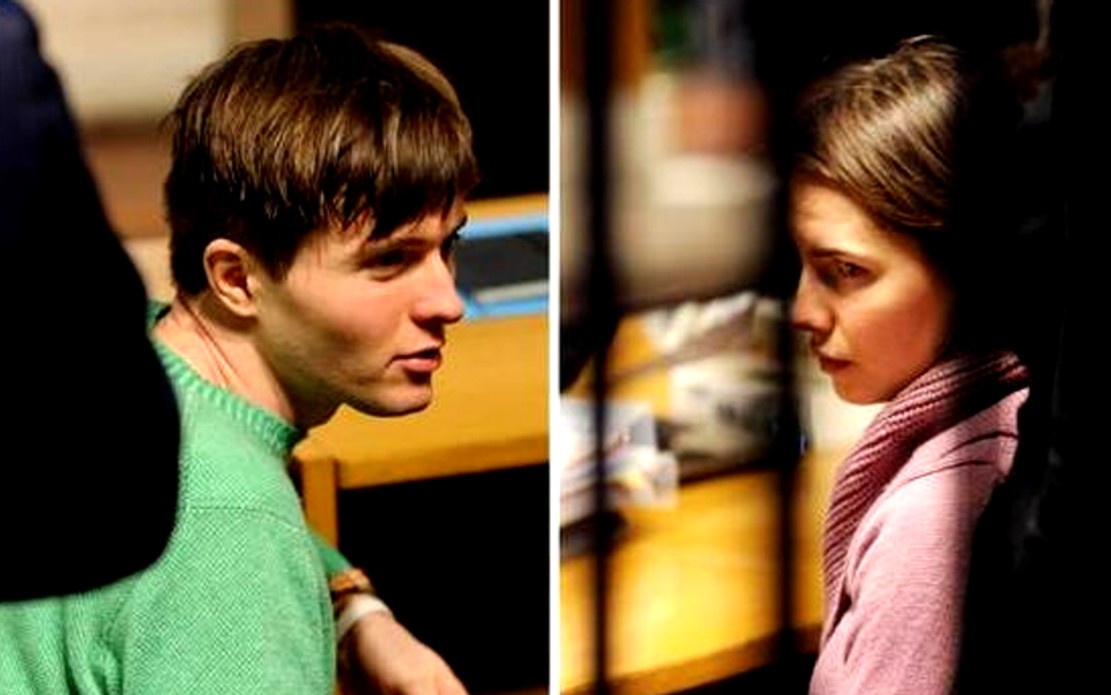
Category: 5 No pack attack hoax
Tuesday, September 27, 2011
Seventeenth Appeal Session: Tough Day Ahead For Raffaele Sollecito’s Lawyers In The Minefield
Posted by Peter Quennell
Today it will be Giulia Bongiorno and Luca Maori for Raffaele Sollecito. Important considerations to bear in mind:
1) There are still all these open questions assembled by lawyer and main poster SomeAlibi and Sollecito chose not to address them on the stand.
2) The Supreme Court has definitively shut down the argument of a possible lone wolf perpetrator and Guede in court accused Sollecito to his face.
3) Attempts to show that Guede did it with others (Alessi’s testimony) or two or three others did it (Aviello) both descended into farce.
4) A staged attempt by Bongiorno using a staff member to try to scale the wall of the house to Filomena’s window descended into farce.
5) Sollecito referred to Amanda Knox as a liar in his third alibi and in effect implicated her by saying that on the night she was absent for four hours.
6) Solleito has still not explained his phone record or computer record or how his DNA could have got onto Meredith’s bra clasp.
7) Sollecito has still not explained the other physical evidence tying him to the scene: how his bloody footprint ended up on the bathroom mat.
His family faces a trial for releasing an evidence tape to a TV station, and for attempting to subvert justice by involving national politicians. And the family have still not rebutted Aviello’s charge that a bribe was waved at him to testify.
Not a pretty mess, by any means. Good luck, Bongiorno and Maori.
Tuesday, February 01, 2011
Explaining The Massei Report: A Visual Guide To The Faked Break-In Via Filomena’s Window
Posted by pat az
1. Post Overview
Cross-posted from my own website on Meredith’s case at the kind invitation of TJMK.
The Massei Report on the trial and sentencing of Amanda Knox and Raffaele Sollecito looks into whether or not a break-in is supported by the evidence available in the room with the broken window.
It concludes that the broken window and room in disarray - Filomena’s bedroom - are an “artificial representation”, ie. that the break-in was faked. After seven pages of review of the evidence, the Massei Report states:
“the situation of disorder in Romanelli’s room and the breaking of the window pane constitute an artificial representation created in order to orient the investigations towards a person who, not having the key to the front door, was supposed to have entered through the previously broken window and then effected the violent acts on Meredith which caused her death.
What follows is a look at the comments in the Massei report compared with crime scene and other photos. All quotes are from the English translation prepared by unpaid volunteers at PerugiaMurderFile.org. The section on the scenes in the bedroom begins on page 47 and continues to page 55. Some sentences in the paragraphs below have been omitted for brevity, and can be read in full in the original.
2. Knox Finds The Scene
Then (Amanda) went into another room and noticed that the window had been broken and that there was glass inside. She told these things to her and the other girls present. Then she related that she had gone back to Raffaele’s house and had rung Filomena.
I)n one of the telephone calls to Romanelli, Amanda spoke of that smashed window and of the possibility that someone could have entered the house through the broken place; she said this also in the telephone call to 112 and in the first declarations to the Postal Police.
Also in the e-mail of November 4, 2007, sent by Amanda to 25 people in the US, she hypothesises that a burglar could have entered the house and says she looked around to see if anything was missing.
Filomena Romanelli, disturbed by this phone call, had rung Amanda back without receiving a reply and when, a little later, she had succeeded in speaking to Amanda, Amanda had told her that in her room (i.e., in Ms. Romanelli’s room) the windowpane was broken, everything was in a mess, and that she should come back home.
Filomena Romanelli had ascertained from a quick check of her room, even though (it was) in a complete mess with the windowpane broken, that nothing was missing.
It must be held that when Filomena Romanelli left the house in via della Pergola, she had pulled the [interior] shutters towards the interior of her room, although she did not think that she had actually closed them; furthermore, because they were old and the wood had swelled a bit, they rubbed on the windowsill; to pull them towards the room it was necessary to use some force (“they rubbed on the windowsill”); but in this way, once they had been pulled in, as Romanelli remembered doing, they remained well closed by the pressure of the swelled wood against the windowsill.
It cannot be assumed - as the Defence Consultant did - that the [interior] shutters were left completely open, since this contradicts the declarations of Romanelli, which appear to be detailed and entirely likely, considering that she was actually leaving for the holiday and had some things of value in her room; already she did not feel quite safe because window-frames were in wood without any grille.
Also, the circumstance of the [interior] shutters being wide open does not correspond to their position when they were found and described by witnesses on November 2, and photographed (cf. photo 11 already mentioned).
Now, for a rock to have been able to break the glass of the window without shattering the outside shutters, it would have been necessary to remove the obstacle of the shutters by opening them up.
Consequently, since the shutters had been pulled together and their rubbing put pressure on the windowsill on which they rested, it would have first been necessary to effect an operation with the specific goal of completely opening these shutters.
The failure to find any instrument suitable for making such an opening (one cannot even see what type of instrument could be used to this end) leads one to assume that the wall would have to have been scaled a first time in order to effect the complete opening of the shutters, in order to enable the burglar to aim at the window and smash it by throwing a large stone - the one found in Romanelli’s room.
He would then have to have returned underneath Romanelli’s window for the second climb, and through the broken glass, open the window (balanced on his knees or feet on the outside part of the windowsill), otherwise he would not have been able to pass his arm through the hole in the glass made by the stone) and reach up to the latch that fastened the window casements, necessarily latched since otherwise, if the casements had not been latched, it would not have been necessary to throw a rock at all, but just to open the shutters and climb inside.
The “climber” would also need to rely on the fact that the [interior] shutters were not actually latched, and also that the “scuri” ]blackout blind] had not been fastened to the window-frame to which the broken pane was attached; otherwise it would not have been possible to open them from the outside; nor would it have been possible, even breaking the glass, to make a hole giving access to the house, since if these inner panels had been closed, they would have continued to provide an adequate obstacle to the possibility of opening the window, in spite of the broken pane.
This scenario appears totally unlikely, given the effort involved (going twice underneath the window, going up to throw the stone, scaling the wall twice) and taking into account the uncertainty of success (having to count on the two favourable circumstances indicated above), with a repetition of movements and behaviours, all of which could easily be seen by anyone who happened to be passing by on the street or actually coming into the house.
But beyond these considerations, there are other elements which tend to exclude the possibility that a burglar could have entered the house through the window of Romanelli’s room.The double climb necessary to attain the height of three and a half metres would have left some kind of trace or imprint on the wall, especially on the points on the wall that the “climber” would have used to support his feet, all the more as both the witnesses Romanelli and Marco Zaroli gave statements indicating that the earth, on that early November evening, must have been very wet (..6) (p50)
In fact, there are no visible signs on the wall, and furthermore, it can be observed that the nail ““ this was noted by this Court of Assizes during the inspection ““ remained where it was: it seems very unlikely that the climber, given the position of that nail and its characteristics, visible in the photo 11, did not somehow “encounter” that nail and force it, inadvertently or by using it as a foothold, causing it to fall or at least bend it. (p50)
The next fact to consider is that the pieces of glass from the broken pane were distributed in a homogeneous manner on the inside and outside parts of the windowsill, without any displacement being noted or any piece of glass being found on the ground underneath the window.
This circumstance, as confirmed also by the consultant Pasquali, tends to exclude the possibility that the rock was thrown from outside the house to create access to the house through the window after the breaking of the pane. The climber, in leaning his hands and then his feet or knees on the windowsill, would have caused at least some piece of glass to fall, or at least would have been obliged to shift some pieces of glass in order to avoid being wounded by them.
Instead, no piece of glass was found under the window, and no sign of any wound was seen on the pieces of glass found in Romanelli’s room. It can moreover be observed that the presence of many pieces of glass on the outside part of the windowsill increases the probability of finding some small pieces of glass on the ground underneath, since there seems to be no reason that so many pieces of glass would all stop just at the edge of the windowsill without any of them flying beyond the edge and falling down to the garden below. (p51 & 52)
On this subject it is also useful to recall that at the hearing of April 23, 2009, the witness Gioia Brocci mentioned above declared that she had observed the exterior of the house, paying particular attention to the wall underneath the window with the broken pane, the window of the room then occupied by Filomena Romanelli.
She said: “We observed both the wall”¦underneath the window and all of the vegetation underneath the window, and we noted that there were no traces on the wall, no traces of earth, of grass, nothing, no streaks, nothing at all, and none [39] of the vegetation underneath the window appeared to have been trampled; nothing” (p. 142 declarations of Gioia Brocci). (51)
This situation, like all the other glaring inconsistencies, is adequately and satisfactorily explained if one supposes that the rock was thrown from the inside of the room, with the two shutters pulled inwards so that they blocked the pieces of glass from falling to the ground below. Once the glass had been broken from inside, the rock was set down at some place in the room, and the shutters were pushed towards the outside, being thus opened from within the room. (p51)
But the fact that all this was in fact just a simulation, a staging, can be deduced from further circumstances. From the photos taken by the personnel of the Questura (photos 47 to 54 and 65 to 66) one can perceive an activity which appears to have been performed with the goal of creating a situation of obvious disorder in Romanelli’s room, but does not appear to be the result of actual ransacking, true searching for the kind of valuable objects that might tempt a burglar.
The drawers of the little dresser next to the bed were not even opened (photo 51 and declarations of Battistelli who noted that Romanelli was the one who opened the drawers, having found them closed and with no sign of having been rifled: see p. 66 of Battistelli’s declarations, hearing of Feb. 6, 2009).
The objects on the shelves in photo 52 appear not to have been touched at all; piles of clothes seem to have been thrown down from the closet (photo 54) but it does not seem that there was any serious search in the closet, in which some clothes and some boxes remained in place without showing any signs of an actual search for valuable items that might have been there (photo 54).
It does not appear that the boxes on the table were opened (photo 65) in a search for valuable items. And indeed, no valuable item (cf. declarations of Romanelli) was taken, or even set aside to be taken, by the ““ at this point we can say phantom ““ burglar.
What has been explained up to now thus leads to the assertion that the situation of disorder in Romanelli’s room and the breaking of the window pane constitute an artificial representation created in order to orient the investigations towards a person who, not having the key to the front door, was supposed to have entered through the previously broken window and then effected the violent acts on Meredith which caused her death.
Footnotes
(...1) The Massei Report in English is readable and downloadable via the link at the top of this page.
(..2) The consultant for the defence actually assumed that this had been done; in his exhibit, he assumed that the shutters were not present in front of the window
(..3): “if the shutters were closed, he could not have passed through, that is obvious”, cf. declarations of the consultant for the defence, Sergeant Francesco Pasquali, p. 22 hearing July 3, 2009.
(..4): (the window in Romanelli’s room is located at a height of more than three and a half metres from the ground underneath, cf. photo 11 from the relevant dossier)
(..5):,which are the wooden panels [scuri=non-louvered shutters in interior of room] that usually constitute the outer side (or the inner, depending on the point of view) of the window [attached to the outer edge of the inner side of the window-frame]
Saturday, December 18, 2010
First Reports On Scope Of Appeal Sounds Like Maybe A Setback For The Defenses
Posted by Peter Quennell
The first full reports are not out yet. This is a first quick take on the Italian reporting and may be subject to correction.
Some of the Cassation’s hard-line decision for rejecting Rudy Guede ‘s 10 appeal grounds in Rome on thursday will indeed be accepted into this appeal for the judges’ consideration.
The judges are agreeing to the defense request for a review of the testing of the DNA on the bra clasp and the large knife, though of course nobody - nobody - so far has ever proved contamination as the prosecutors today pointed out.
Two Rome experts in DNA have already been nominated.
Apparently none of the other very extensive forensic evidence at the scene of the crime - which is the entire apartment, not merely Meredith’s bedroom - is to be retested. That has always been very tough to explain away.
Apparently only one or two of the previous witnesses whose testimony is described in the Massei report will be heard from again. Possible Guede confidant Alessi will be allowed and maybe Aviello who claimed his missing brother really did it.
And apparently ninety days is added to the allowed duration of this appeal, because the Massei Report took 90 days to produce. The deadline now is next September, although if it lasts through to the spring we will be surprised.
The defense doesn’t seem to have many strong hopes going forward. No more Spiderman attempts on Filomena’s window. They found no room for appeal with regard to the various contradictory alibis, the various peculiar phone calls, and assorted bizarre behaviors.
Remember that even Knox and Sollecito themselves have claimed they were zonked out of their skulls on the night - though magically they seem to have managed a major cleanup and rearrangement of the entire crime scene, minus evidence pointing to Guede.
The astute commenter Piktor posted this on PMF
The expert review would be needed if the scientific results were the only evidence that convicts.
What if the DNA evidence was thrown out. Could you convict without it?
You have the staging, the lies, the false accusation, the police testimony, the defendant’s multiple alibis that don’t mesh, Mrs. Mellas testimony in court exposing Knox’s willful “confusion”, the email and diaries.
You add it up and it all points in one direction. No doubt about the result.
The prosecution narrative makes sense. The defence has no narrative.
Sunday, May 30, 2010
Questions For Knox And Sollecito: Ten From Daily Beast As Knox Calunnia #2 Trial Starts
Posted by Peter Quennell
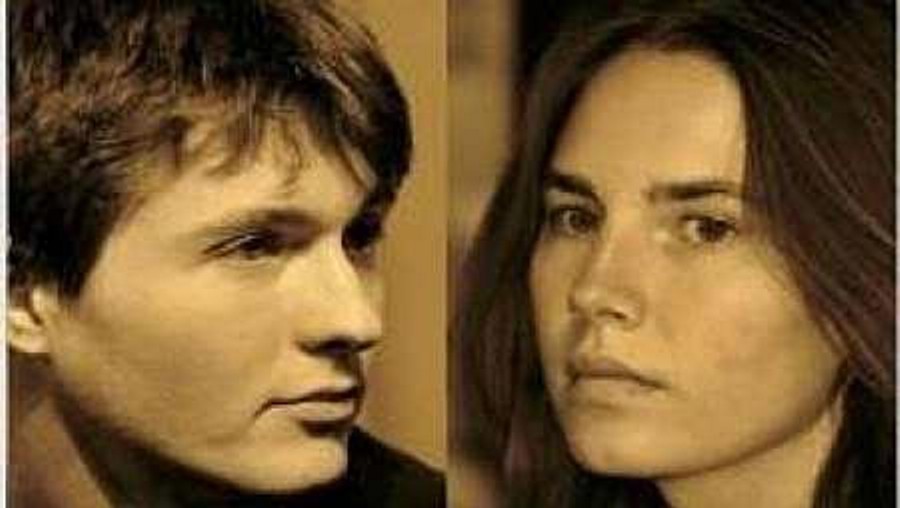
This Daily Beast report indicates that the cancelled jailhouse TV interview with Amanda Knox was a lot more firmed-up than Knox’s stepfather, Chris Mellas, seems to have claimed.
And it outlines the first phase of Knox’s Calunnia #2 trial which is based on charges brought by the interrogating police, all of whom testified at her trial that she was treated well during her interrogations as a witness and suspect. .
Click the image or link above above for the fine reporter Barbie Nadeau’s full article on some issues Knox has never been able to account for, including Knox’s callous skipping of Meredith’s memorial service.
The ten questions are all very tough, and each would also have been asked by the jury. Here they are:
.:
It’s back to court for Amanda Knox, the 22-year-old Seattle native currently serving 26 years in prison in Italy for sexually assaulting and murdering her British roommate, Meredith Kercher.
This week, Knox is expected to attend a preliminary hearing on slander charges lodged against her for accusing Perugia police of abuse. During her testimony at her murder trial last June, she accused the cops of slapping her on the back of the head during an interrogation just days after Kercher’s body was discovered in November 2007.
The police deny hitting her, and Knox’s own lawyers have never filed charges for the alleged abuse. If she is convicted of slander, a judge could add six years to her sentence….
Knox’s resurgence in the headlines was to coincide with a joint jailhouse interview she had granted to ABC News and the Italian broadcaster Mediaset’s Matrix program. But the bureau of prisons denied the interview in the final hour, effectively silencing Knox indefinitely.
A high-profile jailhouse interview with Knox is considered the Holy Grail by journalists covering the case, and the American and Italian networks have been vying for a chance to ask Knox a few questions on camera. Now it is unlikely anyone will get an interview before Knox’s appeal hearings this fall.
But if we did, there are a few questions we’d want her to put to rest.
1. Why did you and Raffaele Sollecito turn off your cell phones at the same time the night of November 1, 2007 and on again at the same time the next morning? You told the police that you and Raffaele slept late the morning of November 2, 2007, but phone records show that you both turned your phones back on very early that morning. How could that be?
2. Why were you bleeding? Your lawyers agree with the prosecution’s findings that at least one of the spots of Meredith’s blood found in the house where she was killed had your blood mixed with it. Your mother told me that you had your period. Your stepfather told others that your ear piercings were infected. Which was it?
3. Once you realized your mistake in blaming Patrick Lumumba for Meredith’s murder, why didn’t you tell the authorities? You told your mother that you felt bad about it, so why didn’t you alert an official so Patrick could be set free?
4. Why did you go with Raffaele to the police station on November 5? You were not called in for questioning. Did you realize at that time that you were both under suspicion?
5. Why weren’t your and Raffaele’s fingerprints found in your house after the murder if the two of you had spent time there that morning and the day before? Only one half-print on a glass in the kitchen has been attributed to you, yet you have claimed that you took a shower there that morning. How did you spend so much time there and leave virtually no trace?
6. Why did you take the mop and bucket from your house over to Raffaele’s house? You told the prosecutor during your testimony in June 2009 that you took the mop and bucket to his house to clean up a leak under his kitchen sink. But by your own testimony, the leak was miniscule and could have been easily cleaned up without it. What were you really doing with the mop?
7. What would you do differently if you had a chance to rewind the clock back to November 3, 2007? Would you go to the memorial service for Meredith? Would you still have gone to the police station with Raffaele? Would you have left for Germany when your aunt asked you to?
8. What do you think happened the night Meredith was killed? You have professed your innocence. Who do you think killed her and under what circumstances?
9. What do you really think of the Italian justice system? You told an Italian parliamentarian that you got a fair trial, and you even thanked the prosecutors for trying to solve the mystery of Meredith’s death, but your supporters at home in Seattle maintain that the Italian system is corrupt and unfair. What is your real view?
10. Is there anything you wish you would have said in court during your trial? You talked about your vibrator and about how you did not want an assassin’s mask forced on you. But in your final appeal after the closing arguments on December 4, 2010, why didn’t you say the words, “I did not kill Meredith Kercher?” Raffaele did when it was his turn to speak. Why didn’t you?
Our posting soon of the judges’ sentencing report will open up dozens of new questions for Knox. Such as: “How did you track Meredith’s blood into your own room and leave three traces revealed by luminol?”
Thursday, October 08, 2009
Newsweek’s Barbie Nadeau Has A Really Vital Piece On How The Evidence Stacks Up
Posted by Peter Quennell
And, in short, it is ominous.
Click above for the full report. This really IS vital reading. A few key excerpts as follows.
Evidence: Rudy Guede
Who it hurts: Knox and Sollecito
Rudy Guede is the 24-year-old Ivory Coast native convicted in a fast-track trial last October for his role in Kercher’s murder. He is serving a 30-year sentence (his appeal begins on Nov. 19). Guede, who refused to testify in the Knox trial, has admitted that he was in the house when Kercher was killed. He says Kercher invited him there and that the two were making out when a stomach cramp from a bad kebab sent him to the bathroom. He was on the toilet with his iPod headphones on through four songs and, when he came out, Kercher was dying. He says he tried to save Kercher by using a towel to sop up the blood on her neck wounds, but he was scared after a man he says looked like Sollecito told him that “they’ll pin this on the black guy.” Guede fled to Germany, where he was later arrested for skipping a train fare. His feces (found in a toilet), along with his DNA and fingerprints from Kercher’s bedroom, link him to the crime scene. The sentencing judge who convicted him, though, did not see him as a lone assailant. Instead, the judge wrote in his sentencing report that he believed Guede acted with Knox and Sollecito.
Evidence: Murder dynamic
Who it hurts: Knox and Sollecito
One of the most complicated aspects of Kercher’s tragic death is how the murder itself played out. The prosecution believes that Knox, Sollecito, and Guede taunted Kercher in a sex game that quickly escalated to violence and ended in murder. Countless forensic experts, including those who performed the autopsies on Kercher’s body, have testified that more than one person killed her based on the size and location of her injuries and the fact that she didn’t fight back””no hair or skin was found under her fingernails. The defense has confused matters more: Knox’s forensic specialist testified that Kercher had been killed by only one person from the front, but Sollecito’s expert testified that Kercher had been killed by one person from behind.
Evidence: Knox’s confession
Who it hurts: Knox
On Nov. 5, 2007, Sollecito was called to the Perugia police station for questioning about Kercher’s murder. Knox testified last June that she did not want to be alone, so she accompanied him. During his interrogation, Sollecito admitted to police that he did not know for sure if Knox actually spent the night of the murder at his house, as she had told police earlier. Since Knox was at the police station, the head of the murder squad decided to ask her a few questions. Her interrogation started at about 11 p.m., and, by 5:45 a.m., Knox had told police that she was in the house when Kercher died””and that Patrick Lumumba, the owner of the nightclub where she worked, was the assailant. She even described Kercher’s screams. She, Sollecito, and Lumumba were arrested. The next day, Knox wrote a five-page memorandum reiterating everything she said the night before. But since there was no lawyer present during her interrogation””and so far no one has produced an audiotape of the interrogation””Knox’s attorneys were able to have her verbal confession thrown out of evidence. The five-page memorandum still holds….
Evidence: Conflicting alibis
Who it hurts: Unknown
Knox maintains that she spent the night of Nov. 1, 2007, at Sollecito’s house. Sollecito did not take the stand during this trial, and his lawyer told NEWSWEEK that it was, at least in part, because he could not corroborate Knox’s alibi….
So Sollecito did not take the stand in part because he could not corroborate Knox’s alibi. Wow. That has to hurt.
Very much more in Barbie Nadeau’s original piece. We recommend that you read it all.
Wednesday, August 19, 2009
Case For The Prosecution #4: Amanda Knox’s Multiple Conflicting Alibis
Posted by The Machine
The Knox Alibis: How They Conflict
The first three posts on the power of the case were on the DNA evidence, the luminol-enhanced footprint evidence, and Raffaele Sollecito’s various conflicting alibis.
Now we look at the various conflicting alibis that Amanda Knox has given for the night in question. We dont yet have full transcripts and have to rely on what was reported in the UK press.
Please click here for more
Thursday, July 30, 2009
Case For The Prosecution: #3 Raffele Sollecito’s Multiple Conflicting Alibis
Posted by The Machine

[above: Sollecito with his lawyer Giulia Bongiorno; click for a larger image]
The Sollecito Alibis: How They Conflict
The first two posts on the power of the case were on the DNA evidence, and the luminol-enhanced footprint evidence.
In this and the next post we will elaborate upon the testimony relevant to the multiple alibis given by Amanda Knox and Raffaele Sollecito and the evolving circumstances in which they were given.
Following the discovery of Meredith’s body in her house, more than a dozen possible witnesses were quite expeditiously questioned: Meredith’s various English friends, her two Italian housemates, the four boys who lived downstairs, and Knox and Sollecito.
Meredith’s English friends, her two Italian housemates, and the boys downstairs fully cooperated with the police. They seemed to be telling the truth. They had one alibi each that could readily be verified. Those alibis never changed.
As a direct result they were all quickly eliminated from the investigation.
In stark contrast, Amanda Knox and Raffaele Sollecito appeared to be obfuscating. They appeared callous, impatient, arrogant, and reluctant to cooperate with the police.
These were attitudes first publicly noted as incriminating in mid 2008 by the judges at the Italian Supreme Court. Police and prosecution did not leak.
Knox and Sollecito each made three separate attempts to come up with credible alibis. All appeared desperate and semi-rehearsed. None of them made total sense or managed to get them off the hook. Neither helped the other at all.
Today, we address Sollecito’s alibis.
The prosecution undermined them in various ways. Sollecito did not take the stand at trial to repeat any of them. His occasional interventions in the courtroom did not strengthen any of them. He made no attempt to corroborate the third alibi of Knox (that she was at his place all night) and immediately prior to arrest he said she had made him lie.
Everyone at and around trial knew of the wariness and extreme anger of the two (and their families) and how they knocked chips off one another whenever they could.
Innocent behavior? You decide. If each was not blaming the other for their plight this behavior would be unique in the history of crime.
Raffaele Sollecito’s first alibi
For his first alibi Raffaele Sollecito claimed, in an interview with Kate Mansey from the Sunday Mirror, that he and Amanda Knox were at a friend’s party on the night of the murder. It appears that this is the alibi that Sollecito also first told the police.
As there seems to have been no party, or in any case no party they attended, it would have been difficult for Sollecito to find any witnesses, and so this alibi was quickly superceded.
Raffaele Sollecito’s second alibi
For his second alibi Sollecito now claimed that he was at his apartment throughout the night with Amanda Knox.
This alibi was contradicted by the forensic evidence presented by the prosecution. According to the testimony of the scientific police from Rome, there were six separate pieces of forensic evidence that placed him in the cottage on Via Della Pergola on the night of the murder.
These included an abundant amount of his DNA on Meredith’s bra clasp, and a bloody footprint on the blue bathmat in Meredith’s bathroom which appears to match the precise characteristics of his foot.
Sollecito’s claim that he was at his apartment the whole evening on 1 November was also undermined by Amanda Knox, who claimed in one of her own witness statements that he was also at the cottage when Meredith was killed:
Yes we were in the house. That evening we wanted to have a bit of fun. We were drunk. We asked her to join us. Diya wanted her. Raffaele and I went into another room and then I heard screams.
This alibi was also undermined by an eyewitness, Antonio Curatolo, the watcher in the park above the house, who testified that he saw Sollecito there. And it was undermined by Sollecito himself when he moved to the third alibi below.
In my previous statement I told a load of rubbish because Amanda had convinced me of her version of the facts and I didn’t think about the inconsistencies.
Although Rudy Guede exercised his right to silence when he was called as a witness in the present trial, it should be noted that at his own trial last October and in the stated grounds for his appeal, he has claimed that Amanda Knox and Raffaele Sollecito were both at the cottage on the night in question, and that they were responsible for Meredith’s murder.
Raffaele Sollecito’s third alibi
Sollecito was asked to return to the police station on 5 November to answer some more questions. He was at that time confronted with telephone records that proved that he and Amanda Knox had lied previously.
So for his third alibi, which now cut Amanda Knox loose and implicated her, Sollecito claimed that he was at his apartment all evening, and that for part of the evening Knox was out, from 9 pm to 1 am.
In my previous statement I told a load of rubbish because Amanda had convinced me of her version of the facts and I didn’t think about the inconsistencies….
Amanda and I went into town at around 6pm, but I don’t remember what we did. We stayed there until around 8.30 or 9pm.
At 9pm I went home alone and Amanda said that she was going to Le Chic because she wanted to meet some friends. We said goodbye. I went home, I rolled myself a spliff and made some dinner.”
He goes on to say that Amanda returned to his house at around 1am and the couple went to bed, although he couldn’t remember if they had sex.
This third alibi was undercut by Amanda Knox when she took the stand and testified. She stated that she was with Sollecito at his place all night.
It was also contradicted by the forensic evidence presented by the prosecution: the six separate pieces of forensic evidence that placed him in the cottage on Via Della Pergola on the night of the murder.
This third alibi was also undermined by the telephone records and by the data taken from his computer.
Sollecito claimed that he had spoken to his father at 11 pm. The phone records showed that to the contrary, there was no telephone conversation at this time, though Sollecito’s father had called him a couple of hours earlier, at 8.40 pm.
Sollecito claimed that he was surfing the internet from 11 pm to 1 am. Marco Trotta, a police computer expert, testified that the last human interaction on Sollecito’s computer that evening was at 9.10 pm and the next human activity on Sollecito’s computer was at 5.32 am.
Sollecito said that he downloaded and watched the film Amelie during the night. However, Mr Trotta said that the film had been watched at around 6.30 pm, and it was earlier testified that Meredith returned to the cottage she shared with Amanda Knox at about 9 pm.
Sollecito claimed that he had slept in until 10 am the next day. There was expert prosecution testimony that his mobile phone was actually turned on at 6.02 am. The Italian Supreme Court remarked that his night must have been “sleepless” to say the least.
This alibi was undermined by the eyewitness Antonio Curatolo, the watcher in the park above the house, who testified that he saw Sollecito there.
Sollecito’s difficult situation resulting
Sollecito does not seem to have done himself any favours by exercising his right to remain silent and not to testify at the trial.
As things now stand, he does not have any credible alibi or scenario for the night of the murder. Also it would appear that he has damaged his overall credibility irreparably, by giving three alibis that differed so considerably.
Judge Paolo Micheli had in front of him much of the same evidence. He wrote, in committing Raffaele Sollecito to trial last October, that he considered the triple alibis to be a clear indication of guilt.
There seems to be no obvious reason right now why the present judges and jury would conclude differently.
Thursday, July 23, 2009
Case For The Prosecution: #2 The Tough Footprint Evidence
Posted by The Machine
1. Preamble
This series is a summary of the prosecution’s case in five parts, with a commentary on matters of key significance.
The material has been reordered so that evidence presented at several points in the trial can be described in one post here. Sources used are the many published reports and some transcripts made of the testimony. The first post, below, was on the formidable DNA evidence.
In this post we now elaborate the footprint evidence, some of which is easily visible and some of which is only apparent with the use of luminol.
We reported what happened in the court here and here.
Kermit in his Powerpoint series provided us with accurate prior analysis and post analysis of these flootprints and shoeprints, and Kermit also presented a Powerpoint map of the cottage.
2. About luminol
Luminol is a chemical that reacts with the microscopic particles of iron in the blood if a partial but incomplete attempt has been made to clean a bloodstain away.
The blood traces glow a bright blue quite fleetingly in the dark under luminol, just long enough to allow forensic investigators to measure and photograph it.
Luminol evidence can be among the most compelling. If bloodstains show up under luminol, but not to the naked eye, then it is almost a complete certainty that a crime-scene clean-up has been attempted.
Lorenzo Rinaldi is the director of the print-identity division of Italy’s scientific police, the Italian equivalent of Scotland Yard or the FBI. He testified that one visible and three luminol-revealed footprints and a visible shoeprint belonged to the present two defendants, Amanda Knox and Raffaele Sollecito. (Another shoeprint belonged to Guede, convicted last October.)
3. Evidence Against Amanda Knox
Amanda Knox’s footprints were found set in Meredith’s blood in two places in the hallway of the new wing of Meredith’s house. . One print was exiting her own room, and one print was outside Meredith’s room, facing into the room. These bloody footprints were only revealed under luminol.
The fact that there was an absence of any visible bloody footprints from Meredith’s room where Meredith’s blood was to the visible bloody footprint on the blue bathmat in the bathroom that Meredith and Knox shared strongly indicates that some prints were successfully cleaned away altogether.
A woman’s bloody shoeprint which matched Amanda Knox’s foot size was found on a pillow under Meredith’s body. Barbie Nadeau noted the significance of this evidence on The Daily Beast website:
“When the judge asked Rinaldi the size of an unidentified bloody shoeprint found on the pillow below Kercher’s body, he responded, “Between 36 and 38.” The judge then asked Rinaldi what size shoe Knox wears. “The Skecher shoe we sequestered belonging to Amanda Knox corresponds with size 37.”
The significance of the woman’s bloody shoeprint in Meredith’s room is considerable. By itself it debunks the myth that some had propagated for a while, that Rudy Guede acted alone. The bloody shoeprint was incompatible with Meredith’s shoe size.
4. Raffaele Sollecito
Two bloody footprints were attributed to Raffaele Sollecito. One of them was revealed by luminol in the hallway, and the other one was easily visible to the naked eye on the blue bathmat in Meredith’s and Knox’s shared bathroom.
Lorenzo Rinaldi excluded the possibility that the bloody footprint on the blue bathmat was the right size or shape to belong to Knox or Guede instead of Sollecito: “You can see clearly that this bloody footprint on the rug does not belong to Mr. Guede, but you can see that it is compatible with Sollecito.”
Andrea Vogt’s report for the Seattle Post-Intelligencer shows just how meticulous and painstakingly detailed the analysis of the bloody footprints was:
“All the elements are compatible with Mr. Sollecito’s foot,” Rinaldi said, pointing with a red laser to a millimeter-by-millimeter analysis of Sollecito’s footprint projected onto a big-screen in the courtroom. He used similar methods to exclude that the footprint on the bath mat could possibly be Guede’s or Knox’s.
“Those bare footprints cannot be mine,” said Sollecito in a spontaneous statement…. But the next witness, another print expert, again confirmed Rinaldi’s testimony, that the print, which only shows the top half of the foot, matches the precise characteristics of Sollecito’s foot….
Rinaldi’s detailed PPT described methods of image analysis, metric and grid measurement of the ball, toe, heel and arch, as well the particular characteristics of the footprints and shoeprints as well as the actual shoes and feet of Knox, Sollecito and Guede. The three suspects gave their footprints and fingerprints at police headquarters.”
Another print expert also testified that the bloody footprint on the blue bathmat matched the precise characteristics of Sollecito’s foot.
Amanda Knox’s lawyer, Luciano Ghirga, asked Dr. Stefanoni to confirm that other substances like bleach or fruit juice can also react to luminol.
Dr. Stefanoni acknowledged that they do, but pointed out that biologists who work regularly on crime scenes distinguish easily between the bright blue glow of a blood trace and the much fainter glow from other reactive substances
Tuesday, July 21, 2009
Case For The Prosecution: #1 The DNA Evidence
Posted by The Machine

[Above: Prosecutor Manuela Comodi, click for larger image]
1. Preamble
Nearly 200 hours over 23 days.
That is how long the prosecution took to present its voluminous case against Amanda Knox and Raffaele Sollecito, including time taken by the defense teams to conduct cross-examinations.
This series is a summary of the prosecution’s case in five parts, with a commentary on matters of key significance. The material has been reordered so that for example the DNA evidence presented at several points in the trial can all be described in one post here.
Sources used are the many published reports and some transcripts made of the testimony. All the main witnesses will be named in this series with a brief mention of who they are and their qualifications.
Two past posts that may aid in understanding the DNA testimony are Nicki’s post here and Fiori’s post here. All past DNA posts can be found in this area.
2. The Large Double DNA Kitchen Knife
The double DNA knife is the knife that was sequestered from Sollecito’s apartment. Although there was an imprint of another knife at the scene, and one defense expert argued that there may have been yet another, it remains plausible that this is the weapon that was used to murder Meredith.
Dr. Patrizia Stefanoni was the leader of the forensic team from Rome that carried out all the forensic collections at Meredith’s house. She testified unequivocally about the knife. A small sample of Meredith’s DNA was found to be in a groove on the blade, and Amanda Knox’s DNA was found to be on the handle.
Dr. Stefanoni noted that there were peculiar diagonal scrapes on the knife blade, which suggested that the knife had been vigorously cleaned.
Both Dr. Renato Biondo, the head of the DNA Unit of the scientific police, and the Kerchers’ own DNA expert, Professor Francesca Torricelli, provided independent confirmation that this forensic finding is accurate and reliable.
The defence teams’ forensic experts are not disputing that Meredith’s DNA was on the blade of the knife. Instead they are arguing that the knife was somehow contaminated for the DNA to actually be there.
Dr Stefanoni has firmly excluded this possibility of contamination in transit or in the laboratory. She testified that there hasn’t been a single instance of contamination in her laboratory for at least the last seven years, and every precaution was taken here to ensure that different traces were not mixed.
A police officer who led a search of Sollecito’s apartment added weight to the prosecution’s assertion that the double DNA knife had been cleaned with bleach. He testified that he had been struck by “the powerful smell of bleach”.
When Raffaele Sollecito heard that the scientific police had found Meredith’s DNA on the double DNA knife in his apartment, he did not deny the possibility of the DNA being there.
Instead he made a claim about accidentally pricking Meredith’s hand whilst cooking at his apartment. “The fact that Meredith’s DNA is on my kitchen knife is because once, when we were all cooking together, I accidentally pricked her hand.’‘
However Meredith had never been to Sollecito’s apartment and so it seems Sollecito could not have accidentally pricked her hand there whilst he was cooking. In attempting to explain the presence of Meredith’s DNA on the blade, he did so in a way easily disproved and seemed to further implicate Amanda Knox and himself.
3. Sollecito’s DNA On Meredith’s Bra Clasp
An abundant amount of Raffaele Sollecito’s DNA was found on Meredith’s bra clasp, and Dr. Stefanoni has excluded the possibility of any contamination.
This is the bra clasp that was collected some weeks after the first forensic collection and it was conceded that it should have been collected earlier. It was also argued that valid DNA evidence in other cases is often collected weeks or months or even years after the crime when a suspect object is unearthed.
Sollecito’s lawyer Ms Buongiorno is perhaps not surprisingly claiming that this bra clasp was also contaminated in the laboratory. The problem for them is to explain precisely where such an abundant amount of Sollecito’s DNA could have come from, and how it was so firmly imprinted.
The only other instance of Sollecito’s DNA at the cottage was found on a cigarette butt in the kitchen, seemingly an unlikely source at best.
It would seem unlikely that the judges and jury will conclude that the bra clasp was contaminated in a strictly controlled laboratory where Dr. Stefanoni follows rigorous laboratory procedures. She is an internationally renowned and very experienced forensic expert and was part of a Disaster Investigations Team which identified disaster victims via their DNA.
Alberto Intini is the head of the Italian police forensic science unit. Andrea Vogt reported as follows in the Seattle Post-Intelligencer on Mr Intini’s testimony about the possibility or otherwise of contamination:
“Alberto Intini maintained that the crime scene had not been contaminated and pointed out that laboratory testing revealed none of the investigators’ prints or biological traces. Mr Intini said “In fact, it is the results that tell you if it was done correctly, and I can tell you that in this investigation there was not even one trace of any of our operators.”
He also pointed out that unless contamination has been proved, it does not exist. “It is possible in the abstract that there could have been contamination, but until this is proved, it does not exist.”
The prosecution demonstrated on the final full day of testimony that Meredith’s bra was actually removed with a knife some time after she had been killed.
Judge Paolo Micheli presided over the fast-track trial of Rudy Guede and committed Sollecito and Knox to trial. In looking at the identical evidence he asked “Who had a reason to come back, cut off Meredith’s bra, and move her body some time later?”
The present judges and jury might conclude differently, but Judge Micheli concluded that it would only have been done by someone who knew about Meredith’s death and had an interest in arranging the scene in Meredith’s room to point away from themselves. He discounted Rudy Guede, who apparently went home, cleaned himself up, and then was seen out on the town.
4. Knox Blood With Meredith’s
There were five instances of Amanda Knox’s blood or DNA mixed with Meredith’s blood in three different locations in the cottage in Via della Pergola: the bathroom, the hallway, and Filomena’s bedroom.
Amanda Knox’s blood was found mingled with Meredith’s blood in three places in the bathroom: on the ledge of the basin, on the bidet, and on a box of Q Tips cotton swabs.
Dr. Stefanoni testified that it would have been “strange” that three traces of blood with both Meredith’s and Amanda Knox’s DNA would have been left at different times.
Barbie Nadeau in Newsweek pointed out a reason why the blood stains must have been left on the night of the murder:
“Legal experts who follow this case have suggested that blood evidence cannot be dated and therefore could have been left weeks before the murder. But when Knox testified in her own defense in June, she conceded that there was no blood in the bathroom the day before the murder, effectively dating those blood stains to that night.”
Perhaps Knox had a bloody earring piercing, and maybe a drop landed on a drop of Meredith’s blood. But in three different places? Perhaps it is not surprising that the defence lawyers have not brought up the subject of the mixed DNA in the bathroom in their part of the trial.
Meredith’s blood was found on the top part of the light switch in the bathroom she shared with Amanda Knox. This suggests that it was deposited there when the light was switched on. Meredith’s blood was also found on the toilet lid. There were no DNA or other physical traces of Rudy Guede in that bathroom.
Knox’s DNA and Meredith’s DNA was also found mixed together in a bloody footprint in the hallway of the new wing of the house.
A mixture of Knox’s DNA and Meredith’s blood was also found in Filomena’s room. This seems to be compelling evidence because Knox had never claimed she entered Filomena’s room when she checked the cottage. This room was the scene of the alleged break-in, and there were glass fragments on the floor.
Meredith’s blood had been cleaned up in this room, but it was nevertheless revealed by luminol.
Barbie Nadeau concludes in a Daily Beast report that the mixture of Knox’s DNA and Meredith’s blood in Filomena’s room seems more incriminating than the double DNA knife:
“But perhaps more damning even than the knife was Stefanoni’s testimony that a mix of Knox’s DNA and Kercher’s blood was found on the floor in the bedroom of a third roommate, Filomena Romanelli.”
Friday, July 03, 2009
Trial: Prosecution Giving Defense Expert Hard Time Over Guede Break-in Theory
Posted by Peter Quennell
Italian media are reporting on a tough cross-examination of a defense expert this morning.
Francesco Pasquali, a former marshall, showed a video to the court, with three simulations of a large rock being thrown through Filomena’s window, and a theory of how a burglar could have scaled the 4-meter wall and entered the room through the window, leaving no body evidence or any blood where the glass was broken.
For the experiment, the consultant explained, a window and bedroom similar to those of the house (same size, same material and same paint) were constructed. Shots were made with two cameras, one external and one internal to the room, which is in same size and the same decor as Ms Romanelli’s….
The prosecution, represented by Giuliano Mignini and Manuela Comodi, presented a number of objections to the thesis of the expert, such as that in the reconstruction of the events the presence of curtains on the window were not taken into account.
The curtains would have presumably stopped any glass fragments from flying into the room.
It is also being remarked that the defense has not, either for-real or in today’s simulation, had anyone actually climb the 4-meter-high wall and enter through the window, and then place the glass fragments on TOP of Filomena’s clothes scattered around the room.
As Kermit explained there are actually FIVE easier entry-points to the house (1) all more in the dark and less observable from the street, (2) each of which would have required less in the way of acrobatics or walking back and forth, (3) all might have caused no noise or broken glass.

